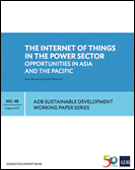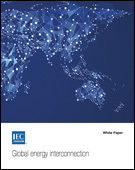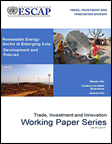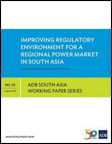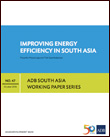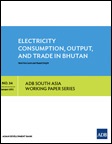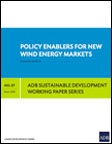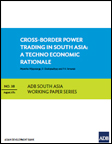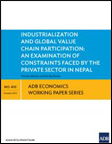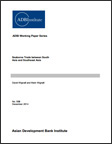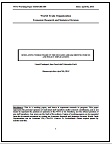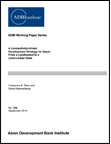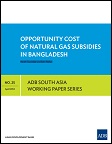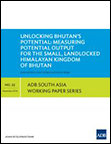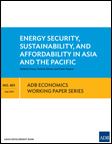Energy Results
Energy demand in the SASEC subregion is expected to increase over the next decade resulting from economic growth and rising per capita incomes and energy consumption. With energy resources in South Asia unevenly spread, regional energy cooperation could help countries develop their energy resources in an optimal manner to lower energy costs, improve regional energy security, and contribute to climate change mitigation. SASEC initiatives in the energy sector support improvement of energy trade infrastructure, developing a regional power market by harmonizing legal and regulatory frameworks, and developing low-carbon alternatives and conservation and energy efficiency measures.
ENERGY REGIONAL & INTERNATIONAL
WORKING PAPERS
total items: 17This paper asserts that advances in information technology have allowed companies to know more about individual consumers. This has challenged theories that assume consumers to be identical, where goods and services that enter regional value chains are slow to respond to changing demands. The paper predicts that countries and firms will succeed depending on how they will integrate consumer information into the process of value addition.
Source: Matthias Helble
This brief considers how Bay of Bengal Initiative for Multi-Sectoral Technical and Economic Cooperation (BIMSTEC) stands to gain by leveraging existing transport connectivity projects in the region. It looks at how initiatives, including those under the South Asia Subregional Economic Cooperation (SASEC) Program and other groups, build connectivity through standards harmonization, multimodal integration, and development of national single windows.
Source: K. Yhome
Asia’s power sector struggles to upgrade power systems and keep up with growing demand. The Internet of Things (IoT) has the potential to transform the power sector by optimizing operations and lowering costs for consumers. The power sector is already reaping the benefits of adoption of smart meters and smart thermostats, two consumer-oriented IoT applications. The Asian Development Bank has committed to smart grid projects in India, through a Green Energy Corridor and Grid Strengthening Project, and Maldives, through the Preparing Outer Islands for Sustainable Energy Development (Phase 1).
Source: Arun Ramamurthy and Pramod Jain
Sustainable energy and climate change are major global concerns, yet three billion people around the world rely on wood, coal, or animal waste for cooking and heating. The interconnection of grids would open up opportunities for resource sharing and bring clean energy to much more of the world. This paper assesses benefits and outlines policy, technical, and economic preconditions for global energy interconnection. It analyzes global transmission scenarios and evaluates their impact on energy supplies and the environment. It also gives recommendations for setting standards, and where stakeholder involvement is necessary.
Rapid economic growth in emerging Asia has led to a critical increase of greenhouse gas emissions. Transitioning to renewable energy sources would help reduce emissions. However, massive investment is needed to make that transition. According to this paper, targeted policy interventions are needed to facilitate trade and investment in the renewable energy sector and create “green jobs” in the low-carbon and resource-efficient sectors.
Countries in South Asia continue to experience poor access to energy, energy shortages, and concerns for energy security. Bilateral energy trading, with its limited scope, leaves untapped the vast economic, reliability, and environmental benefits of energy cooperation in the region. Improving access to modern energy sources through regional cooperation contributes toward economic growth, and better and more sustainable living conditions in South Asia. Regional energy cooperation supports the development of regional primary energy sources to generate electricity, cross-border transmission infrastructure, and a regional framework that will coordinate energy resource development and trade of electricity across the region. However, this will only be possible with appropriate policies and harmonized legal and regulatory frameworks in all necessary systems. Experience across the world indicates that such legal and regulatory changes can be accomplished successfully.
Source: Anoop Singh, Priyantha Wijayatunga, and P. N. Fernando
This paper examines areas where the efficiency of South Asian power systems could be significantly increased, such as the operation of thermal power plants and transmission systems. It also looks at ways to increase conservation by users through time-of-use electricity tariffs, appliance standards, and demand control through smart metering. It concludes that South Asia has a significant potential for energy efficiency improvement in the power sector, which can be realized by implementing policies and programs that can readily complement the existing institutional framework.
This ADB South Asia Working Paper examines the relationship between electricity consumption, international trade, and economic growth using an augmented production function framework. The findings show that Bhutan is energy-dependent and can promote economic growth through future investment in hydropower. More specifically, the results show that a 1% increase in (i) electricity consumption generates 0.03%-0.05% increase in output, (ii) total trade results in 0.5% increase in output, (iii) trade openness results in 1% increase in output.
Source: Hooi Hooi Lean and Russell Smyth
This publication focuses on the wind energy policies that can support sustained development of wind power in emerging wind energy markets. The policies are based on the work done by Quantum Leap in Wind Power Development in Asia and the Pacific (QLW). QLW is a $2 million, 3-year project funded by the Asian Development Bank, to facilitate wind power sector development in developing countries. The success and failures of wind energy policies in Mongolia, the Philippines, and Sri Lanka – including its impact and evolution – are analyzed in this report.
Source: Pramod Jain and Bo An
South Asian countries have a wealth of diverse energy sources. These renewable resources, along with the varying electricity demand patterns among countries in South Asia, open up opportunities to share resources through electricity trading, which can be enabled by strengthening the electricity transmission system. This study examines the cost and benefit of six cross-border electricity transmission interconnections, and measures the economic and reliability benefits for participating countries in South Asia.
Source: Priyantha Wijayatunga, D. Chattopadhyay and P. N. Fernando
This paper examines the constraints behind and beyond Nepal's borders that hinder its full participation in global value chains (GVC). Basing the analysis on recent and relevant publications, key economic data, and interviews with policymakers and stakeholders, the authors explain how weak and uncertain industrial policy has led to de-industrialization. They also looked at the effects of inadequate infrastructure, energy shortage, and inefficient transit. Failures in coordination, shallow regional integration and non-tariff barriers also bar further growth of Nepal's industrial development and GVC participation. The authors recommend necessary domestic reforms for behind-the-border constraints, and subregional partnerships—facilitated through the South Asia Subregional Economic Cooperation program—for beyond-the-border challenges.
This Asian Development Bank Institute paper examines trade and the main ports around the Bay of Bengal to identify projects that will enable trade and contribute to improved maritime infrastructure. It also reviews the nature of trade and trade patterns, particularly through the Indian East Coast Corridor study. The paper develops further strategic options for seaport adjustment around the Bay of Bengal to support trade evolution, policy assessment, and other constraints.
Source: David Wignall, Mark Wignall
This working paper considers economic prospects up to the year 2100, offering assumptions about key exogenous variables, providing a baseline for climate change policy evaluation, and discussing sectoral and trade issues. The paper combines an economic growth model with a multi-sectoral model to construct scenarios for around 150 countries up to a maximum time horizon of 2035, with forecasts on a number of key variables such as energy prices, demographics, etc. It suggests that trends toward increased regionalization may be reversed, with multilateral trade relationships gaining in importance.
Transforming Nepal from a landlocked into a land-linked state, the authors argue, could be key to unlocking the country's much-awaited growth. With its strategic location between India and the People's Republic of China, a connectivity-driven development strategy could energize Nepal's lackluster post-conflict economic performance. Further, Nepal implements a multi-track approach to promoting regional cooperation and integration in connectivity with its neighbors, reinforced through participation in South Asian Association for Regional Cooperation, Bay of Bengal Initiative for Multi-Sectoral Technical and Economic Cooperation, and South Asia Subregional Economic Cooperation. By identifying ten priority projects that could further boost Nepal's connectivity, the paper also discusses how strengthening Nepal's transport, energy, and trade links could benefit the region. However, the authors also warn against “internal threats” to Nepal's development—corruption and the country's difficult political situation.
This paper examines the impact of optimal gas pricing policy using a general equilibrium model for the Bangladesh economy. It estimates the opportunity cost of underpricing or subsidizing gas in Bangladesh. It further explores the potential impacts of an increase in investment on social and physical infrastructure using the social accounting matrix multiplier model. The results reveal that Bangladesh is losing a significant development opportunity due to its gas subsidy. Calculations using a dynamic computable general equilibrium model suggest that withdrawal of the gas subsidy along with increased investments in physical and social infrastructure would lead to positive macroeconomic and sectoral effects in Bangladesh.
The hydropower sector has driven Bhutan's economic growth in the past two decades with growth rates averaging 7.9%. Yet, the economy has not been invulnerable to market fluctuations and external shocks. This ADB South Asia Working Paper analyzes how Bhutan can create sustainable and inclusive growth, alongside the continuous expansion of its hydropower industry. It examines how certain policies can impact Bhutan's potential growth over 2013–2030. Results show that higher investment in education, health, and efforts to diversify its economic base—including enhancement of new industries with linkages to regional and global value chains—can further drive economic growth and improve the country's living standards.
Source: Sabyasachi Mitra, Sarah Carrington, and Anthony Baluga
Energy security, sustainability, and affordability from 2010 to 2035 for Asian Development Bank’s Asia and Pacific members are calculated in this working paper, including potential benefits of integrating energy systems regionally. Based on business-as-usual and alternative scenarios, outlook on SASEC member countries by 2035 include (i) dramatic improvement in Bhutan's energy efficiency, (ii) slight decrease in Bangladesh's energy intensity—although carbon dioxide will increase in its primary energy mix, as dependence on fossil fuels rise, and (iii) decrease in energy self-sufficiency of SASEC member countries by 2035, but improved energy affordability. Since renewable energy sources and importation of energy may be capital-intensive, requiring additional tariff support, regional cooperation can enhance affordability and energy security—with Bhutan and Nepal standing to benefit greatly from energy integration in South Asia.



